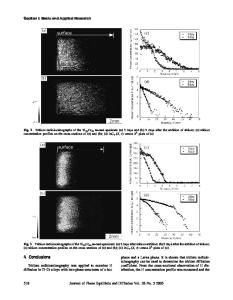Hydrogen diffusion coefficients in the titanium alloys IMI 834, Ti 10-2-3, Ti 21 S, and alloy C
- PDF / 1,432,261 Bytes
- 11 Pages / 612 x 792 pts (letter) Page_size
- 38 Downloads / 320 Views
I. INTRODUCTION
BECAUSE of the excellent combination of high strength and low density, titanium alloys are suitable materials for the application in aircraft construction or aerospace engineering.[1,2,3] However, besides the relatively high costs of these alloys, considerable restrictions exist in their applicability under conditions where hydrogen (e.g., as fuel or a fuel component) is present due to the strong affinity between titanium and hydrogen that may result in a severe deterioration in the mechanical properties. In the case of alpha titanium alloys, hydrogen embrittlement is attributed to several mechanisms. A main reason for embrittlement is the low solubility of hydrogen in the hexagonal closed packed structure as compared to the body centered cubic beta phase. This leads to the formation of hydrides in the alpha phase and associated diminished fracture toughness and ductility.[4] Furthermore, it has been shown that mechanical tensile stresses at the crack tip promote the formation of hydride precipitates via an autocatalytic mechanism, if the crack propagation rate is slow enough to allow a sufficient amount of hydrogen to diffuse to the crack tip.[5,6] At enhanced crack growth rates, hydrogenenhanced local plasticity is proposed to be responsible for a macroscopically brittle failure.[6] In contrast to alpha titanium, the susceptibility to hydrogen embrittlement is significantly reduced in titanium alloys of the beta type. Depending on temperature and composition, the bcc beta phase may dissolve up to approximately 10,000 wppm hydrogen (i.e., 50 at. pct) and, therefore, exhibits a reduced tendency for hydride formation.[7,8] The increasing importance of beta titanium alloys has caused a need for systematic studies, which concern the H.-J. CHRIST, Professor, and M. DECKER, Research Assistant, are with the Institut fu¨r Werkstofftechnik, Universita¨t Siegen, D-57068 Siegen, Germany. S. ZEITLER, formerly Research Associate with Universita¨t Siegen, is now with AUDI AG, D-85045 Ingolstadt, Germany. Manuscript submitted February 2, 1998. METALLURGICAL AND MATERIALS TRANSACTIONS A
effect of hydrogen on the mechanical behavior of these alloys. For a more quantitative analysis of this problem, reliable thermodynamic and kinetic data are needed. A considerable number of studies deal with hydrogen diffusion in alpha titanium,[9] but only little information exists on diffusion of hydrogen in commercially available beta titanium alloys. To the authors’ knowledge, solely the data of Holman et al.[10] correspond to a large temperature range, while other studies (e.g., Schulte and Adler[11]) provide values for specific temperatures only. The results presented in this article were obtained as part of an extensive study, which was carried out in order to determine the data necessary to assess the tendency of hydrogen-induced failure of beta titanium alloys with different stabilities of the beta phase. Here, the diffusion coefficients and the related frequency factors and activation energies for the diffusion of hydro
Data Loading...











